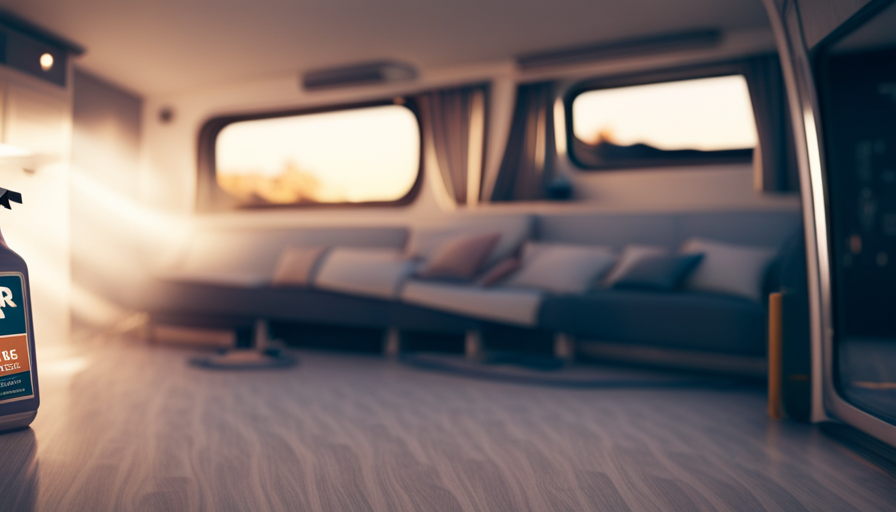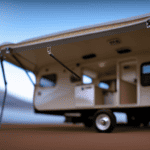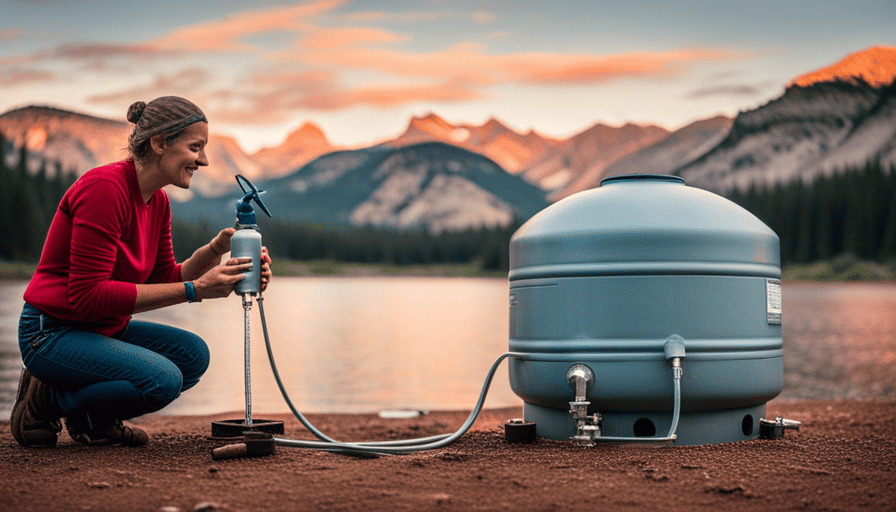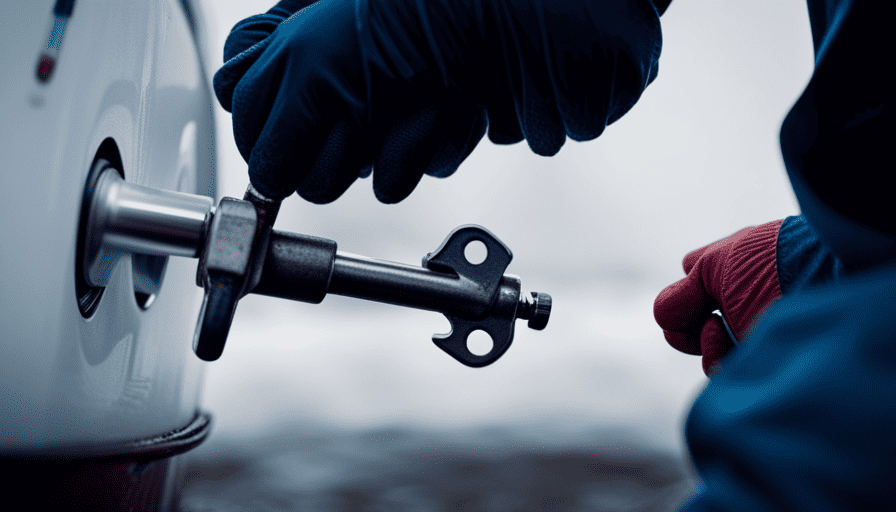While standing under the large pop-up camper, I was impressed by the advanced mechanism that allowed it to smoothly rise up. The mechanism, a perfect combination of gears and cables, was essential for every camping adventure. However, like all complex devices, it required constant maintenance to ensure it worked flawlessly.
In this article, I will guide you through the process of lubricating your pop up camper lift system, ensuring its longevity and hassle-free functionality. From understanding the components and gathering the necessary tools to cleaning, applying lubricant, and regular maintenance, I will provide you with a step-by-step guide.
So, whether you’re preparing for a weekend getaway or a cross-country expedition, follow these instructions to keep your camper’s lift system in optimal condition. Get ready to embark on your camping journey with ease and peace of mind.
Key Takeaways
- Regular maintenance and lubrication are essential for the performance and longevity of a pop-up camper lift system.
- The key components of the lift system, such as lift arms, springs, pulleys, and cables, should be inspected regularly for any signs of damage or wear.
- Proper cleaning of the lift system before lubrication is important to remove dirt, debris, and rust that can affect its functionality.
- Testing and troubleshooting the lift system’s operation, movement, and stability can help identify any issues that may require professional assistance.
Understand the Components of the Lift System
Now that you’ve got your pop up camper ready for adventure, let’s dive into the exciting world of lubricating the lift system! Understanding the components of the lift system is essential before you start lubricating.
The lift system consists of several crucial parts, including the lift arms, springs, pulleys, and cables. These components work together to raise and lower the camper roof.
Identifying common problems with the lift system is the first step in troubleshooting any malfunctions. Some common issues you might encounter include difficulty lifting or lowering the roof, excessive noise during operation, or the lift system not working at all. By understanding these common problems, you can better diagnose and address any issues that may arise.
To troubleshoot lift system malfunctions, start by inspecting the lift arms and springs for any signs of damage or wear. Check the pulleys and cables for fraying or misalignment. Ensure that all components are properly lubricated. Lubrication is essential for smooth operation and prevents excessive wear and tear on the lift system.
Now that you understand the components and common problems of the lift system, let’s move on to the next step: gathering the necessary tools and supplies.
Gather the Necessary Tools and Supplies
Before I start lubricating my pop-up camper lift system, I make sure to gather all the necessary tools and supplies.
To do this, I create a list that includes items such as lubricant spray, a rag, a screwdriver, and a ladder.
It’s important to have everything on hand before starting the process to ensure a smooth and efficient lubrication.
Make a list of the tools and supplies needed for the lubrication process
To get this lubrication party started, you’re gonna need a whole bunch of tools and supplies. Here’s a list of the essentials you’ll need for the job:
-
Lubricant spray: This is the star of the show, make sure you have a high-quality lubricant specifically designed for RV lift systems.
-
Wrench: You’ll need this to remove any bolts or screws that may be securing the lift system.
-
Screwdriver: This handy tool will help you access hard-to-reach areas and remove any covers or panels.
-
Rag or towel: Keep one of these nearby to wipe away any excess lubricant and ensure a clean finish.
-
Step ladder: Depending on the height of your camper, you may need a ladder to reach certain components.
Now that you know the tools needed and supplies required, it’s important to ensure you have all the necessary items on hand before starting. This will help you avoid any interruptions during the lubrication process and keep things running smoothly.
Ensure you have all the necessary items on hand before starting
Make sure you’ve got everything you need before you dive into the fun of giving your RV’s lift system a well-deserved treat. To ensure a smooth lubrication process, it’s important to have a preparation checklist.
Firstly, you’ll need a high-quality lubricant specifically designed for RV lift systems. Additionally, gather a clean cloth or rag, a step ladder for easy access, and a flashlight to inspect hard-to-reach areas. It’s also advisable to have some gloves to protect your hands during the process.
Now, let’s talk about some common lubrication mistakes to avoid. One mistake is using the wrong type of lubricant, which can cause damage to the lift system. Another is not thoroughly cleaning the components before applying the lubricant, as dirt and debris can interfere with the lubrication process. Lastly, neglecting to lubricate all the necessary parts can result in uneven lifting.
With all the tools and supplies ready, let’s move on to preparing the camper for the lubrication process.
Prepare the Camper
First, make sure the camper is fully prepared for the upcoming adventure by addressing the necessary maintenance tasks.
-
Check the tires for proper inflation and any signs of wear. Replace them if necessary to ensure a smooth and safe journey.
-
Inspect the exterior of the camper for any cracks, leaks, or damage. Repair any issues to prevent further damage during the trip.
-
Test all the lights, including brake lights and turn signals, to ensure they’re working properly. Replace any bulbs that are burnt out.
Now that the camper is prepared, it’s time to focus on maintaining the lift system. This is an important step to ensure smooth operation and prevent any breakdowns during your trip.
Before applying any lubricants, it’s crucial to clean the lift system thoroughly. This will remove any dirt, dust, or debris that may have accumulated over time. Cleaning the lift system will also allow the lubricant to penetrate more effectively, resulting in better performance.
Transitioning into the next section, let’s dive into the process of cleaning the lift system to ensure optimal functionality.
Clean the Lift System
Once the camper is fully prepared, it’s important to give attention to cleaning the lift system for optimal functionality and a smooth journey.
To ensure the lift system operates efficiently, it’s crucial to remove any rust and prevent corrosion. Start by inspecting the lift system for any signs of rust or corrosion. Use a wire brush or sandpaper to gently remove any rust from the metal components. Be thorough and make sure all rust is removed to prevent further damage and promote longevity.
Next, clean the lift system by using a mild detergent mixed with water. Avoid using harsh chemicals or solvents that may cause damage. With a soft cloth or sponge, gently scrub the lift system, paying close attention to all the moving parts. This will help remove any dirt, grime, or debris that may hinder the system’s performance.
After cleaning, thoroughly rinse the lift system with clean water to remove any remaining detergent. Dry the components with a clean towel or allow them to air dry completely. This step is crucial in preventing any water or moisture from causing rust or corrosion.
With the lift system now clean and dry, you can proceed to the next step of applying lubricant to the moving parts, ensuring smooth operation and longevity of the system.
Apply Lubricant to the Moving Parts
Now that the lift system is clean and dry, it’s time to give the moving parts a little TLC by applying some lubricant. Proper lubrication is crucial for ensuring smooth operation and prolonging the lifespan of your pop-up camper lift system. When selecting the right lubricant, it is important to choose one specifically designed for use on moving parts. Look for a silicone-based lubricant, as it provides excellent lubrication and is resistant to water and corrosion.
To properly apply the lubricant, follow these steps:
-
Start by referring to the manufacturer’s instructions for any specific lubrication points or recommendations.
-
Use a clean cloth to wipe away any dust or debris from the moving parts.
-
Apply the lubricant generously to all the moving parts. Pay special attention to the lift cables, gears, pulleys, and any other areas that require lubrication.
-
Work the lubricant into the moving parts by gently operating the lift system up and down a few times.
Remember to avoid using excessive amounts of lubricant, as it can attract dirt and debris, leading to potential damage. Once you have applied the lubricant, it’s time to test the lift system to ensure everything is functioning properly.
Test the Lift System
To ensure everything is in working order, it’s time to put the lift system through its paces and test it out, like a well-oiled machine ready to take on any adventure. Here are some steps to help you test the lift system and troubleshoot any issues:
Start by operating the lift system using the crank handle or electric motor. Pay close attention to any unusual noises or resistance that could indicate a problem.
Extend the camper fully and check that it reaches its maximum height without any issues. Look for smooth and steady movement throughout the process.
Next, retract the camper and observe if it lowers evenly and without any jerking or sudden drops. This is crucial for safe and efficient operation.
Test the stability of the camper by gently rocking it from side to side. The lift system should keep the camper stable and prevent excessive movement.
By following these steps, you can identify any potential issues with the lift system and address them accordingly.
Once you have completed the testing, you can move on to the next step of the maintenance process, which is to repeat the lubrication process regularly. This will ensure the lift system continues to function smoothly and extend its lifespan.
Repeat the Lubrication Process Regularly
Make sure to regularly repeat the process of keeping your lift system well-lubricated to ensure smooth and enjoyable camping adventures. Regular maintenance of your pop-up camper lift system is crucial for its optimal performance and longevity. One of the key aspects of this maintenance is the regular application of lubrication.
Lubrication plays a vital role in reducing friction and preventing wear and tear on the various components of the lift system. To maintain a well-lubricated lift system, it is important to follow a consistent schedule of lubrication. Depending on the frequency of use and the manufacturer’s recommendations, lubrication should be performed at least once every camping season. This will ensure that the lift system operates smoothly and efficiently.
To begin the lubrication process, start by cleaning the lift system thoroughly with a mild detergent and water. This will remove any dirt, debris, or old lubricant that may have accumulated. Once the lift system is clean and dry, apply a high-quality lubricant to all moving parts, such as the gears, pulleys, and cables. Be sure to follow the manufacturer’s instructions regarding the type and amount of lubricant to use.
Regular maintenance of your lift system and the importance of lubrication can’t be overstated. By keeping your lift system well-lubricated, you’ll not only ensure its optimal performance but also extend its lifespan. In the next section, we’ll discuss how to inspect the lift system for any issues or damage, which is an essential step in maintaining a safe and reliable pop-up camper lift system.
Inspect for Any Issues or Damage
Regularly checking for any issues or damage is crucial to ensure the safety and reliability of your pop-up camper’s lifting mechanism. It is important to inspect for corrosion and check for proper alignment to identify any potential problems before they worsen. Corrosion can occur due to exposure to moisture and can lead to rust, weakening the components of the lift system. Inspecting for corrosion involves closely examining all metal parts for any signs of rust or deterioration. Additionally, checking for proper alignment ensures that all components are in their correct positions and functioning optimally.
To help you visualize the inspection process, refer to the table below:
| Component | Inspection Steps |
|---|---|
| Metal parts | Look for signs of corrosion or rust |
| Alignment | Ensure all components are properly aligned |
By following these steps and regularly inspecting your pop-up camper’s lift system, you can catch any issues or damage early on and address them promptly. This will help maintain the longevity and functionality of your camper. In the event that you do encounter any major issues or are unsure about the inspection process, it is recommended to seek professional help. They have the expertise and knowledge to identify and fix any problems with your pop-up camper’s lift system.
Seek Professional Help if Needed
If you encounter any major issues or are unsure about the inspection process, it’s advisable to seek professional assistance for your pop-up camper’s lift mechanism. Seeking professional assistance can help ensure that any problems with your lift system are properly diagnosed and repaired, preventing further damage and ensuring safe and efficient operation.
When seeking professional assistance, it’s important to choose a reputable and experienced technician who specializes in pop-up campers. They’ll have the knowledge and expertise to troubleshoot common issues that may arise with your lift system. They can also provide guidance on proper maintenance and lubrication techniques to keep your lift system in optimal condition.
Some common issues that may require professional assistance include a malfunctioning motor, damaged cables, or worn-out pulleys. These issues can affect the overall performance and reliability of your lift system, making it difficult to raise or lower your camper smoothly.
By seeking professional help, you can address these issues promptly and effectively, ensuring that your lift system operates smoothly and effortlessly. This will allow you to enjoy your camping trips without any hassle or inconvenience.
With the help of a professional, you can resolve any problems with your pop-up camper’s lift system and enjoy smooth and effortless operation.
Enjoy Smooth and Effortless Operation
With the guidance of a skilled technician, your pop-up camper will effortlessly glide up and down like a swan gracefully gliding across a serene lake. To ensure smooth and effortless operation, regular maintenance and proper lubrication are essential. Here are some important factors to consider:
-
Importance of regular maintenance:
- Regular maintenance is crucial for the longevity and optimal performance of your pop-up camper lift system.
- It helps prevent wear and tear, rust, and other potential issues that may arise over time.
- By keeping up with regular maintenance, you can avoid costly repairs and ensure a hassle-free camping experience.
-
Common lubrication mistakes to avoid:
- Using the wrong type of lubricant can do more harm than good. Always consult your manufacturer’s guidelines or seek professional advice.
- Over-lubricating can lead to a build-up of excess grease, attracting dirt and debris, which can hinder the smooth operation of the lift system.
- Neglecting to clean the lift system before lubricating can cause dirt and grime to mix with the lubricant, resulting in abrasive particles that can damage the system.
By following these guidelines and seeking professional help when needed, you can enjoy a pop-up camper lift system that operates effortlessly and provides you with years of reliable use. So, take the time to maintain and lubricate your lift system properly, and you’ll be ready for countless memorable camping adventures.
Frequently Asked Questions
How often should the lift system be lubricated?
The lift system of a pop-up camper should be lubricated regularly to ensure smooth operation. Maintaining the lift system is crucial for its longevity and functionality. In addition to lubrication, it’s important to know how to troubleshoot common issues that may arise with the lift system.
By following proper maintenance procedures and addressing any problems promptly, you can ensure that your pop-up camper lift system operates efficiently and reliably for years to come.
What type of lubricant should be used on the lift system?
The best lubricants for a pop-up camper lift system are silicone spray or dry lubricant. These lubricants provide excellent protection against rust and corrosion while reducing friction and ensuring smooth operation.
To properly lubricate the lift system, begin by cleaning any dirt or debris from the components. Then, apply the lubricant to all moving parts, including the lift arms, gears, and pulleys. Be sure to follow the manufacturer’s instructions for proper application and reapply as needed for optimal performance.
Can I use any type of lubricant on the lift system?
Using any type of lubricant on your pop up camper lift system isn’t recommended. Just like putting the wrong fuel in your car can cause damage, using the wrong lubricant can lead to costly repairs. It’s important to use a lubricant specifically designed for lift systems to ensure proper function and prevent wear and tear. Regular maintenance, including proper lubrication, is key to keeping your lift system running smoothly and avoiding potential issues down the road.
Are there any specific areas of the lift system that require extra lubrication?
When it comes to lubricating the pop up camper lift system, there are a few key areas that require extra attention. One common mistake to avoid is using too much lubricant, as this can lead to a buildup of grease and dirt.
To properly lubricate the lift system, start by applying a small amount of lubricant to the main lifting arms and pivot points. Then, extend and retract the system a few times to distribute the lubricant evenly. Finally, wipe away any excess lubricant to prevent attracting dirt and debris.
What are the signs that indicate the lift system needs to be lubricated?
If you notice any unusual noises coming from your pop up camper lift system, such as squeaking or grinding, it may be a sign that it needs lubrication.
Another indicator is if the lifting mechanism feels stiff or difficult to operate.
Regular lubrication of the lift system can prevent these issues and extend its lifespan. By reducing friction, lubrication ensures smooth and efficient operation, preventing wear and tear on the components.
Can the Same Lubrication Method Be Used for Both Camper Slide Outs and Pop Up Camper Lift Systems?
When it comes to lubricating camper slide outs and pop up camper lift systems, it’s essential to use the right method for each. While both components require regular maintenance, they have distinct mechanisms that may necessitate different lubrication methods. Understanding these differences and using the appropriate lubricant for each system ensures smooth and efficient operation, enhancing your overall camping experience.
Conclusion
In conclusion, properly lubricating the lift system of your pop up camper is crucial for its smooth and effortless operation. By following the steps outlined in this article, you can ensure that the moving parts are well-maintained and functioning optimally.
Did you know that regular lubrication can extend the lifespan of your lift system by up to 50%? This simple maintenance task can save you time, money, and potential headaches down the road. So, don’t neglect your pop up camper’s lift system and enjoy worry-free camping adventures for years to come.



















